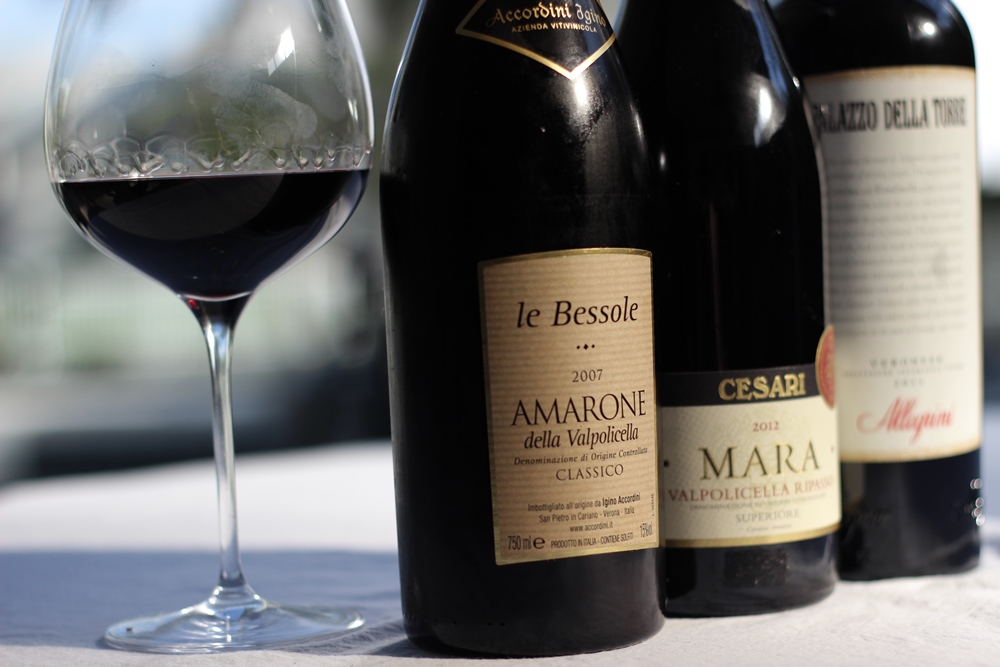You might be ignoring Valpolicella wines – most folks see them as light, fruity red wines with little character or finesse, a wine that you might find in checkered table cloth, red sauce only Italian restaurants. We wanted you to re-think Valpolicella, so the Serious Foodie decided to dispel some of these myths and misconceptions with a wine tasting event featuring reds from the Veneto.
It’s a pity that Valpolicella lost favor with the US market, mainly because of heavy advertising pressure from mass-produced versions (many of which are still light, fruity, and insipid). Like other Italian wines, there has been winemaking renaissance in the region for Valpolicella, spurred by producers of the outstanding artisan Amarone wines such as Allegrini.
The Valpolicella wines are produced solely in the Veneto region, just west of Verona, in an area between foothills of the Alps and Lake Garda. The primary grapes used are Corvina (40-70%), Rondinella (20-40%) and Molinara (5-20%), but the vintner can also add up to 15% complementary varieties, which include Rossignola, Negrara, Trentina, Barbera, Sangiovese, and the recently revived Oseleta grape (almost solely due to efforts at Allegrini). What makes these wines so interesting is the variety of flavors and textures: winemakers have a lot of room for variation with grapes and winemaking techniques. As consumer tastes changed, Valpolicella producers began to use techniques of concentrating and darkening the wines. Some added semi-dried grapes that might have been used for Amarone. Others took Valpolicella and refermented it with the skins and sediment of the semi-dried grapes used for Amarone.
These are fun, food-friendly wines which are generally easy to drink: powerful bouquets, full on the palate with good fruit, velvety, and have a pleasing aftertaste. They also tend to be less tannic than the wines from Tuscany or Piemonte.
For our tasting, we surveyed the five general styles of the Veneto region red wines, selecting Valpolicella Classico Superiore (Tomassi), Valpolicella Superiore Ripasso (Cesari), Amarone della Valpolicella (Accordini), and Ricioto della Valpolicella (Begali). We skipped the Valpolicella Classico, which are light, simple wines – but a good version is the Cesari. Instead, we added the Allegrini Palazzo della Torre – a Valpolicella in every regards, except by designation. It’s a IGT wine (table wine with no government controls), but it is a very interesting version of the Veneto style.
There were 30 people at this event, rating the wines on a scale of 1 to 5 (with 5 being the best).
The Tommasi uses the typical Valpolicella grapes (Corvina Veronese 60%, Rondinella 25% e Molinara 15%), aged for 15 months in Slavonian oak barrels, giving it a nice nuanced structure & balance. There are strong black cherry, currant and red licorice flavors, which are well-meshed in this round, medium-bodied red. For a price of $16 to $18 retail, it is a good value. We paired the wine with a variety of crostini that worked well with the underlying herbal and veggie accents of this wine. It received a 3.3 rating on our 1 to 5 scale.
Palazzo della Torre shows up on a lot of wine lists – it is a very versatile wine, often well-rated by Wine Spectator and others, and is generally well-liked – especially for a wine that is less than $20. As mentioned, this wine is not strictly a Valpolicella, but uses grapes and techniques typical of the region. It is a blend of 70% Corvina Veronese, 25% Rondinella and 5% Sangiovese, made in an innovative ripasso style. After the harvest, the grapes follow two different paths: 70% of the grapes picked are vinified immediately, and the remaining 30% are left to dry until the end of December. The fresh wine made at harvest is blended with the fermenting juice of the dried grapes, initiating a second fermentation, and rendering a more highly concentrated and complex wine. Allegrini affectionately refers to Palazzo della Torre as its “baby Amarone.” The wine pairs well with grilled meats, but works well with salads. It received a 3.9 rating on our 1 to 5 scale.
Ripasso wines are, in general, one of Italy’s best values – well structured, full bodied, both rich and soft at the same time. If you like Napa Cabernet then you’ll want to explore the Valpolicella Superiore Ripasso wines (an official DOC category). The wines are made by macerating Amarone pomace (grape skins & solids) with fresh Valpolicella Classico juice. This particular wine is named after the Cesari family matriarch, Mara, and is made from the typical blend of Covina, Rondinella and Molinara grapes using the Ripasso technique, and aged in Slavonian oak barrels for 12 months. There is a big aromatic bouquet of ripe cherries, which leads to stronger red berry flavors (dried current, sweet black cherry), and quite a bit of licorice. The flavors are persistent, with a nice warm finish along with the round tannins. Like the Allegrini Palazzo della Torre, this wine pairs well with grilled meats, but works well with salads. It received a 3.5 rating on our 1 to 5 scale.
Amarone is one of Italy’s greatest and oddest wines. It’s made from red grapes harvested and then set to dry on racks for 4-5 months, when evaporation has concentrated their sugars considerably. An accidental discovery of yeasts which will allow the dried grapes to be fermented to dryness leaves these wines with the “illusion of sweetness” – but very high in alcohol (at least 14%, but usually 15-16%). There is a minimum of 2 years aging prior to release, with many producers waiting as long as 5 years before release. Amarone can approach amazing levels when aged for 10 or more years. We were lucky to stumble upon a 2007 Accordini Le Bessole at a very reasonable price ($45 per bottle), as these wines can cost hundreds. This version of Amarone was medium to full bodied, with lots of dried fruit flavor, firm tannins, and high acid. We liked the long lasting hints of tobacco mixed with cranberry and cherry. We paired our Amarone with lamb and strong cheeses. It received a resounding 4.5 rating on our 1 to 5 scale.
In the Veneto region, recioto is a process that dates back centuries. Using the same grapes as Amarone, they undergo the same drying process. But fermentation does not go to dryness, leaving residual sugar in the wine. This is one of the few non-fortified red dessert wines, and certinaly one of the finest. It is always extremely concentrated, and wonderfully, if not spectacularly, complex. This is a velvety, rich wine with lots of dried red fruit flavors (cherry, cranberry, lingonberry), hints of plum and blackberry, with some nice spice notes (star anise, cinnamon) – lots of tannin, and bright acidity. It is a mouthful with each sip, with flavors lasting a long time at the end. This will can cellar for 20-30 years under proper conditions. We paired our Recioto della Valpolicella with cheeses, pears, and dried fruit. It was the clear winner of our tasting, receiving a 4.9 rating on our 1 to 5 scale.



